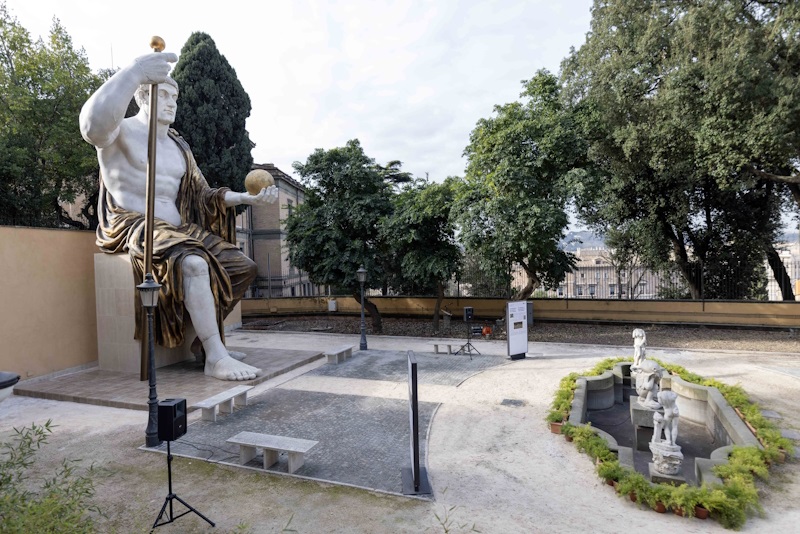The Colossal Statue of Constantine: FREE Exhibition at the Capitoline Museums
by Adriana ruiz
From February 6, 2024 to December 31, 2025, the Capitoline Museums in Rome will host a spectacular exhibition featuring the life-sized reconstruction of the Colossus of Constantine, one of the most impressive statues of ancient Rome. The exhibition, which is free of charge, will take place in the gardens of Villa Caffarelli, where visitors can admire the colossal figure of the emperor who changed the course of history.
Who was Constantine?
Constantine (306-337 AD) was the first Roman emperor to embrace Christianity and to move the capital of the empire from Rome to Constantinople (modern-day Istanbul). He is also known for his military achievements, such as his victory over Maxentius at the Milvian Bridge in 312 AD, which made him the sole ruler of the western part of the empire.
What is the Colossus of Constantine?
The Colossus of Constantine is a huge statue that was made in the early 4th century AD to celebrate the emperor’s power and divinity. It is estimated that the statue was about 12 meters tall and weighed about 40 tons. It was an acrolith, meaning that the head, hands, feet, and other exposed parts were made of marble, while the rest of the body was covered with bronze or marble drapery. The statue was probably placed inside a temple or a basilica, where it would have dominated the space with its imposing presence.
How was the Colossus of Constantine discovered?
The Colossus of Constantine was lost for centuries until the end of the 15th century, when nine marble fragments of the statue were found near the Basilica of Maxentius, where the statue may have originally stood. The fragments were acquired by the Capitoline Museums and displayed in the courtyard of the Palazzo dei Conservatori, where they still remain today. The fragments include the head, the right arm, the left hand, the right knee, the left shin, the right foot, and three pieces of the drapery.
What is the significance of the Colossus of Constantine?
The Colossus of Constantine is not only a masterpiece of ancient art, but also a symbol of the transition from paganism to Christianity in the Roman empire. The statue was made by reusing and modifying an older statue of a bearded emperor or god, possibly Jupiter Optimus Maximus, the chief deity of the Roman pantheon. By transforming the statue into his own likeness, Constantine claimed to be the companion of the gods and the supreme ruler of the empire. The statue also shows the influence of the Homeric tradition, as the bare knee of the emperor is a sign of his authority and benevolence.
What can visitors expect from the exhibition?
The exhibition will offer visitors a unique opportunity to see the Colossus of Constantine in its original dimensions and proportions, thanks to a faithful reconstruction based on scientific and artistic criteria. The reconstruction will be placed in the gardens of Villa Caffarelli, where it will create a striking contrast with the modern cityscape. The exhibition will also feature informative panels, multimedia displays, and other materials that will illustrate the historical and cultural context of the statue, as well as the techniques and challenges involved in its creation and restoration. The exhibition will be a memorable experience for anyone interested in ancient Rome and its legacy.
The display of the Colossus at Villa Caffarelli
The Colossus of Constantine has a fascinating connection with the Temple of Jupiter Optimus Maximus, the most important temple in ancient Rome. The temple, dedicated to the Capitoline triad of Jupiter, Juno, and Minerva, was located on the Capitoline Hill, where the Villa Caffarelli Garden now stands. This is where the life-sized reconstruction of the Colossus of Constantine is displayed in the exhibition.
The temple was built in 509 BC and underwent several renovations and restorations over the centuries. The cult statue of Jupiter, the king of the gods, was also changed several times. The first statue was made of terracotta by a sculptor from Veio, while the later ones were inspired by the famous statue of Zeus by Phidias, the Greek master who created the statue of Zeus at Olympia, one of the seven wonders of the ancient world. The statues of Jupiter were made of marble, with the naked parts attached to a wooden frame covered with metal or marble drapery. The god was depicted sitting on a throne, with his chest, arms, and one knee exposed.
The temple and the statue of Jupiter were damaged by a lightning strike in the early 3rd century AD. This may have been the opportunity for Constantine to reuse the statue and transform it into his own image, as a sign of his divine power and authority. He moved the statue to the Basilica of Maxentius, the last great public building of ancient Rome, where he placed it in a prominent position along the Via Sacra, the sacred road that led to the Roman Forum.
The exhibition allows visitors to appreciate the relationship between the Colossus of Constantine and the Temple of Jupiter, as well as to see the remains of the temple that are still visible in the Exedra of Marcus Aurelius, inside the Capitoline Museums. The exhibition also showcases a historical relief that depicts a sacrifice at the temple of Capitoline Jupiter, performed by Emperor Marcus Aurelius in the 2nd century AD. The relief, which is also preserved in the Capitoline Museums, shows the splendid decoration of the temple’s pediment, with statues of gods and goddesses.
How the Colossus of Constantine was brought back to life

The representatives of Factum Foundation, Sovrintendenza Capitolina and Fondazione Prada during the
progress check inside Factum Foundation’s workshop.
The Colossus of Constantine is a stunning example of how modern technology can help preserve and recreate ancient art. The project to reconstruct the colossal statue was a collaboration between the Sovrintendenza Capitolina, the Fondazione Prada, and the Factum Foundation for Digital Technology in Preservation, a leading company in the field of digitization of works of art. The project started in 2022, on the occasion of the exhibition Recycling Beauty, where the Colossus was first displayed. The project was completed in 2024, when the Colossus was moved to its natural location in the Villa Caffarelli Garden, next to the Temple of Capitoline Jupiter.

Tests for the final Parian marble effect on the facsimile fragments.
The project was based on an archaeological hypothesis that the Colossus was seated and made of marble and bronze. The Factum Foundation used photogrammetry, a technique that uses photographs to create 3D models, to document the ten known fragments of the statue, which are preserved in the courtyard of the Palazzo dei Conservatori and at the Parco Archeologico del Colosseo. The Factum Foundation also used photogrammetry of a cast of a statue of Emperor Claudius as Jupiter, which is now in the Ara Pacis, to model the pose and draping of the Colossus. The Factum Foundation also consulted literary and epigraphic sources and compared the Colossus with other seated statues from the imperial period to reconstruct the missing details.

Factum Foundation re-creating the Colossus of Constantine, 2022.
The Factum Foundation then used 3D printing to make positive casts of the fragments and the recreated sections of the statue. The casts were coated with different materials to imitate the original appearance of the statue. The fragments were coated with a gesso mix and painted to resemble the weathered marble. The recreated sections were coated with resin mixed with marble powder and mica to achieve a clean white color. The cloak and the bronze elements were coated with resin mixed with bronze powder and gilded with gold foil.

A section of the recreated Colossus of Constantine inside Factum Foundation’s workshop.
The original Colossus was about 13 meters tall and had an internal structure made of brick, wood, and metal. The reconstruction used an aluminum support structure, which makes it easier to assemble and disassemble. The reconstruction is faithful to the original dimensions and proportions of the statue, and gives visitors a chance to see the Colossus of Constantine as it once was.
Information
Location
Capitoline Museums , garden of Villa Caffarelli
Hours
From February 6, 2024 Every day from 9.30 am to 6.30 pm
Admission
Free entry
Information
Tel. 060608 (every day from 9.00 am to 7.00 pm)
Photos from Musei in Comune Roma
Read more about:
15 Must-Visit Museums, Galleries, and Cultural Sites in Italy
Don’t Miss the Chance to Visit the Vatican Museums for Free
A Guide to Visiting the Vatican Museums
Italy’s Most Enchanting Towns Accessible by Train
New Celio Archaeological Park in Rome – Free Admission
The Colossal Statue of Constantine: FREE Exhibition at the Capitoline Museums
Learn Italian and open up new possibilities for your career and personal growth
Prepare for the CILS B1 Citizenship exam to obtain citizenship by marriage, residence or study or work in Italy.
Switching to a self-employment permit from a study or job-seeking one
FAQs for Italian Citizenship by Marriage (2023)
Understanding the Tessera Sanitaria: Your Italian Health Insurance Card
Non-Married Partners: How to Obtain a Residence Permit in Italy as De Facto Cohabitants
How to get tax identification number for foreign citizens (Codice Fiscale)
How to register in Italy as an EU citizen
Mastering Public Transport in Italy
The Advantages of Dual Citizenship with an Italian Passport: Unlocking Boundless Opportunities
What you need to know about Visas and Permits to stay in Italy
Red flags to identify a scam when renting in Italy







Leave a Comment:
You must be logged in to post a comment.